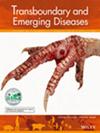Progress Toward Antigenic Epitopes of African Swine Fever Virus and Their Identification
Abstract
African swine fever virus (ASFV) is a highly contagious pathogen that causes pigs to develop high fever, vomiting, diarrhea, and respiratory distress, with an exceptionally high case fatality rate. Unfortunately, vaccine development is hindered by a limited understanding of the structure and function of the protein encoded by ASFV, as well as the mechanisms underlying infection and immunity. Among these factors, the lack of effective cellular epitopes represents a major obstacle to vaccine development. Epitopes serve as the smallest structural units capable of inducing immune responses and are critical targets for both vaccine design and diagnostic reagent development. Therefore, it is imperative to investigate antigens with high immunogenicity and elucidate their correlation with protective immune responses to provide scientific insights and a theoretical foundation for developing safe and effective ASFV vaccines. Currently, thorough reviews on the identification and functional characterization of ASFV antigenic epitopes remain scarce. To address this gap, this paper provides a comprehensive review of ASFV epitopes and their identification strategies. It initiates with a systematic classification of ASFV antigenic epitopes, followed by an extensive discussion of various methods for identifying ASFV epitopes, along with their advantages and limitations. Furthermore, the paper summarizes existing databases of characterized ASFV antigenic epitopes and highlights the most biologically significant ones. In addition, the paper explores emerging applications of ASFV epitopes while addressing the technical challenges in epitope-based research to provide valuable insights for ASFV vaccine development and production.


 求助内容:
求助内容: 应助结果提醒方式:
应助结果提醒方式:


